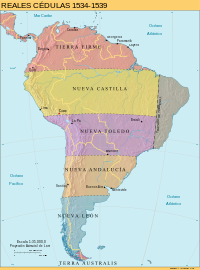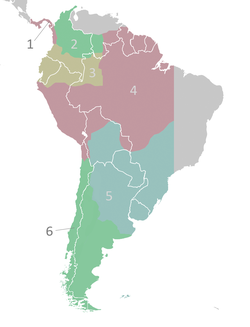Governorate of the Río de la Plata
This article needs additional citations for verification. (May 2009) |
The Governorate of the Río de la Plata (1549−1776) (Spanish: Gobernación del Río de la Plata, pronounced [goβeɾnaˈsjon ðel ˈri.o ðe la ˈplata]) was one of the governorates of the Spanish Empire. It was created in 1549 by Spain in the area around the Río de la Plata.
It was at first simply a renaming of the New Andalusia Governorate and included all of the land between 470 and 670 leagues south of the mouth of the along the Pacific coast. After 1617, Paraguay was separated under a separate administration (Asunción had been the capital of the governorate since Juan de Ayolas.)
After the founding of the Viceroyalty of Peru in 1542, the governorate was since its birth under its authority until the formation of the independent Viceroyalty of the Rio de la Plata in 1776. Similarly, it was under the jurisdiction of the Royal Audience of Charcas until the formation of the independent Royal Audience of Buenos Aires from 1661 to 1671 and after 1783.

Governors of New Andalusia[]
- Adelantado Governor, Captain General, and Pedro de Mendoza (1534–1537). First founding of Buenos Aires; Ft. founded by Juan de Ayolas. Retires and dies mad en route home.
- Governor Juan de Ayolas (1537–1539). In Paraguay. Asunción founded by Juan de Salazar de Espinoza. Killed by natives.
- Lt. Governor (1537–1541). At Buenos Aires, prior to its abandonment.
- Governor Domingo Martínez de Irala (1539–1541). Elected by the colonists.
- Adelantado Governor Alvar Núñez Cabeza de Vaca (1541–1544). Victorious campaign against Guarani in 1542. Arrested and returned to Spain for trial.
Governors of the Río de la Plata[]
- Governor Domingo Martínez de Irala (1544–1556). Encouraged his men to marry and keep concubines from local women. Two adelantados are unable to arrive from Spain and de Irala confirmed in his post by the king 1552. Died peacefully.
- Governor Gonzalo de Mendoza (1556–1558). Ciudad Real de Guayrá founded by in 1557. Died peacefully.
- Governor Francisco Ortiz de Vergara (1558–1569). Elected by the colonists. Foundations fail at San Francisco, Sancti Spiritus, and Santa Cruz de la Sierra. Arrested and returned to Spain for trial.
- Lt. Governor Felipe de Cáceres (1569–1572). Appointed by Royal Audience. Arrested and returned to Spain for trial.
- Adelantado Governor Juan Ortiz de Zárate (1572–1576). Sailed to Spain to confirm his election. Foundation of Tucuman.
- Lt. Governor (1576–1578). Juan Ortiz leaves administration to his daughter Juana, but others de facto governors.
- Lt. Governor Juan de Garay (1578–1583). Buenos Aires refounded 1580.
- Lt. Governor (1583–1587). And de facto governor at Asunción until 1592.
- Adelantado Governor (1587–1592). Judge of the Royal Audience, married to Juana Ortiz de Zárate. Last appointed adelantado.
Governors of the Río de la Plata and Paraguay[]
- Governor Hernando Arias de Saavedra ("Hernandarias") (1592–1594).
- Governor (1594–1595).
- Governor Juan Ramírez de Velasco (1596–1597).
- Governor Hernando Arias de Saavedra (1597–1599). Second time.
- Governor (1599–1600).
- Governor (1600–1602). Appointment formalized 1601.
- Governor Hernando Arias de Saavedra (1602–1609). Third time. First Jesuit Reduction established. Slave trade restricted.
- Governor (1609–1613).
- Governor Mateo Leal de Ayala (1613–1615).
- Governor Hernando Arias de Saavedra (1615–1617). Fourth time. Guayrá (Paraguay) separated into a separate governorate in 1617.
Governors of Río de la Plata[]

- Governor Hernando Arias de Saavedra (1617–1618).
- Governor (1618–1623). Found guilty post mortem of corruption, allowing trade in slaves and contraband to flourish.
- Governor (1623–1624).
- Governor (1624–1631). Continued efforts to pacify the Charrua.
- Governor (1631–1637). Concepción del Bermejo destroyed by natives.
- Governor (1637–1640). Defense of Buenos Aires improved. Expedition against the Calchaquís. erected.
- Governor (or Mujica) (1640–1641).
- Governor (1641).
- Governor Jerónimo Luis de Cabrera (1641–1645). Ban of Portuguese attempted in governorate.
- Governor (1645–1653). Arrested.
- Governor (1653–1660). Three French ships successfully repelled from Buenos Aires. Calchaquís repelled from Santa Fe.
- Governor Alonso Mercado y Villacorta (1660–1663). Request to be able to send two trade ships annually denied. Dutch ships permitted to dock in Buenos Aires.
- Governor (1663–1674). Continued requests for free commerce. The Royal Audience of Buenos Aires briefly independent of the court at Charcas.
- Governor (1674–1678).
- Governor José de Garro (1678–1682). Portuguese expelled from Colonia de Sacramento in 1680.
- Governor (1682–1691). Tucuman relocated.
- Governor (1691–1698).
- Governor (1698–1704). Visit from Danish squadron in Buenos Aires.
- Governor (1704–1708). Colonia de Sacramento retaken.
- Governor Manuel de Velasco y Tejada (1708–1712). Purchased office for 3000 pesos. Arrested.
- Governor (1712).
- Governor Alonso de Arce y Soria (1712–1714). Buys the position for 18,000 pesos. Dies five months later.
- Governor (1714–1715).
- Governor Baltasar García Ros (1715–1717). Colonia del Sacramento returned to the Portuguese. Campaigns against the Charrua, Yaro, and Bohanes.
- Governor Bruno Mauricio de Zabala (1717–1734). Portuguese removed from Montevideo.
- Governor (1734–1742). Expulsion of foreigners from Buenos Aires ordered. Failed attempt to retake Colonia del Sacramento.
- Governor (1742–1745). Refortified Montevideo.
- Governor (1745–1756). First mail delivery opened with Chile and Potosí.
- Governor Pedro Antonio de Cevallos (or Ceballos) (1756–1766). Colonia del Sacramento retaken.
- Governor (1766–1770). English expelled from the Falkland Islands. Mail inaugurated between A Coruña and the Río de la Plata.
- Governor Juan José de Vértiz y Salcedo (1770–1776). After which, the governorate is replaced by the Viceroyalty and Intendancy of Buenos Aires in the Bourbon reforms.
See also[]
- History of Argentina
- History of Paraguay
- History of Uruguay
References[]
- ^ For two, somewhat different interpretations of the boundaries in unsettled areas, see Burkholder, Mark A. and Lyman L. Johnson. Colonial Latin America (10 editions). (New York: Oxford University Press, 1990), Map 2, 73 ISBN 0-19-506110-1; and Lombardi, Cathryn L., John V. Lombardi and K. Lynn Stoner. Latin American History: A Teaching Atlas. (Madison: The University of Wisconsin Press, 1983), 29. ISBN 0-299-09714-5
- Governorate of the Río de la Plata
- Governorates of the Spanish Empire
- Colonial Paraguay
- Spanish colonization of the Americas
- Viceroyalty of the Río de la Plata
- Former political divisions related to Argentina
- 1549 establishments in the Viceroyalty of Peru
- 1776 disestablishments in the Viceroyalty of Peru
- 1776 disestablishments in the Viceroyalty of the Río de la Plata
- States and territories established in 1549
- States and territories disestablished in 1776
- 16th century in the Viceroyalty of Peru
- 17th century in the Viceroyalty of Peru
- 18th century in the Viceroyalty of Peru
- 18th century in Argentina